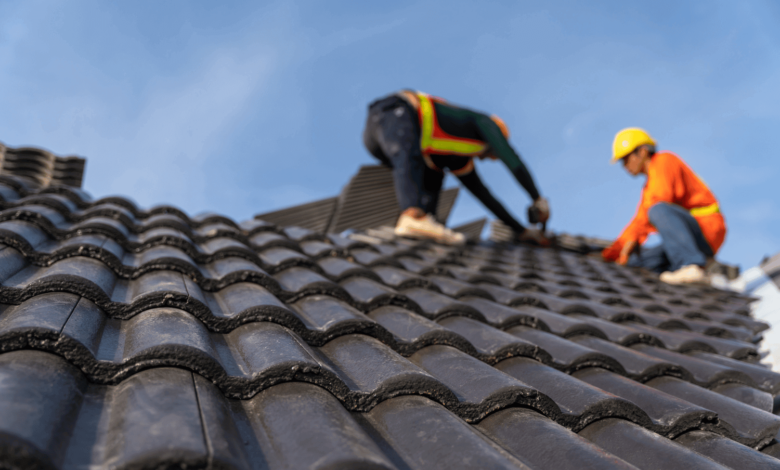Transform Your Home’s Aesthetics with Custom Tile Roofing: A Comprehensive Guide

Key Takeaways:
- Custom tile roofing offers aesthetic appeal and functionality, with materials like clay and concrete providing durability and energy efficiency.
- Tile roofs enhance architectural beauty, adding elegance and tradition to diverse home designs.
- Common tile materials include clay, concrete, and slate, each offering unique benefits in durability and aesthetics.
- Color and pattern selections for tile roofing can significantly affect a home’s visual impact, allowing for creative expression.
- Eco-friendly tile options help reduce environmental impact while enhancing aesthetic appeal.
- Hiring experienced professionals for installation is crucial for ensuring quality and longevity of the tile roof.
- Proper installation procedures are essential to avoid common pitfalls, such as misalignment and material selection issues.
- Routine inspections and maintenance are key to maintaining the longevity and performance of tile roofing.
- Regular cleaning prevents the buildup of moss and debris that can lead to decay, sustaining the roof’s beauty.
- Seasonal maintenance is necessary to prepare for weather changes and prevent damage from natural elements.
Understanding the Allure of Custom Tile Roofing
What Sets Tile Roofing Apart? The Unique Benefits
Custom tile roofing has become a favored choice for homeowners seeking both aesthetics and functionality. The distinctiveness of tile roofing lies not only in its visual appeal but also in its robust performance. Tile roofing materials, typically made from clay or concrete, are known for their durability and long lifespan, often outlasting more traditional roofing materials like asphalt shingles. They resist rot, insects, and adverse weather conditions such as strong winds and heavy rainfall, which contributes to their longevity. Moreover, tile roofing can provide substantial insulation, keeping homes cooler in summer and warmer in winter, thereby enhancing energy efficiency. Beyond practical considerations, many are drawn to the aesthetic richness that tile roofing brings. It offers a wide variety of colors, shapes, and textures which can be tailored to fit different architectural styles. This level of customization allows homeowners to reflect their personal style and elevate their home’s curb appeal significantly.
The Role of Tile Roofing in Architectural Beauty
Tile roofing serves as more than just a protective layer over a home; it acts as a defining design feature that significantly enhances architectural beauty. In many cultures, tile roofs are synonymous with elegance and sophistication. They evoke a sense of tradition, especially in Mediterranean, Spanish, and even older European styles, where clay tiles are a typical sight. However, modern innovations have expanded the appeal of tile roofing beyond these traditional uses. Contemporary designs now incorporate metal tiles, synthetic materials, and a range of finishes that fit sleek, minimalist aesthetics. The versatility of tile roofing allows it to complement various home styles—from rustic farmhouses and lavish villas to sleek modern structures—turning heads and sparking admiration in any neighborhood.
Types of Tile Materials: Choosing What Fits Your Vision
When it comes to tile roofing, the selection of materials plays a crucial role in determining both the functionality and aesthetic appeal of the roof. The most common types of tiles are clay, concrete, and slate. Clay tiles, often associated with traditional architecture, come in a variety of colors and shapes, offering an extensive array of design options. They are incredibly durable and typically have a life expectancy of over 50 years, making them a worthwhile investment for homeowners. On the other hand, concrete tiles, which are an economical alternative to clay, provide a similar look but tend to be heavier. They can be molded into various shapes and styles, allowing for greater creativity in design. Finally, slate tiles are renowned for their natural beauty and exceptional durability—offering a luxurious finish while being resistant to fire and moisture. Understanding the nuances of each type of tile material not only helps you to realize the aesthetic possibilities but also to align your choice with your home’s style and environmental needs.
Designing Your Dream Roof: Inspiration and Ideas
Color Palettes and Patterns: Making a Statement
When it comes to tile roofing, color and pattern can dramatically influence the overall aesthetic of your home. Bold colors, such as vibrant reds or deep blues, can create striking contrasts against the backdrop of your house, making it stand out in the neighborhood. For a more subdued look, earth tones such as browns, greens, and grays offer a classic, timeless appeal that blends harmoniously with natural surroundings. Patterns formed from different tile orientations or sizes can also enhance visual interest and depth. For instance, a herringbone pattern or staggered layouts can create unique textures and help frame architectural elements. As homeowners engage in the creative process, it is essential to consider not only personal style but also how color and pattern choices interact with surrounding elements, ensuring a cohesive and inviting look.
Integrating Eco-Friendly Options into Your Design
As environmental awareness continues to grow, integrating eco-friendly options into your roofing design has never been more crucial. Modern tile roofing materials, especially when crafted from sustainable practices, can significantly reduce the environmental impact of your home. Clay and concrete tiles, for example, can be made from local, natural resources which minimizes transportation emissions and supports local economies. Additionally, many tiles are highly reflective, reducing heat absorption and enabling homes to stay cooler, which in turn can lower energy costs. Furthermore, consider using solar tiles that combine functionality and aesthetic appeal, providing energy generation potential while maintaining the classic look of tile roofing. By prioritizing sustainability in your roofing design, not only do you enhance your home’s aesthetic appeal, but you contribute positively to the environment.
Classic vs. Contemporary: Finding Your Perfect Style
Choosing a tile roofing style that resonates with your design preferences is an essential aspect of home renovations. Classic styles tend to exude grace and tradition, often characterized by terracotta clay tiles or natural slate in rich hues. These options are well suited for historic homes or those designed in Mediterranean or Spanish Revival styles. Conversely, contemporary styles thrive on bold new designs and innovative materials, incorporating sleek geometry and unexpected hues. This might involve the use of synthetic tiles that mimic natural materials while being more lightweight and versatile. Homeowners should assess their current architectural elements, neighborhood style, and personal preferences, weighing both classic and contemporary options to ensure a well-rounded decision.
Installing Custom Tile Roofing: What You Need to Know
Hiring the Right Professionals: Why Expertise Matters
The installation of custom tile roofing is not an endeavor that should be taken lightly; it requires skilled hands and a trained eye. Hiring the right professionals is crucial, as their expertise can make a significant difference in both the quality and longevity of your roof. Look for contractors with substantial experience in tile roofing specifically, as they possess an understanding of the unique challenges associated with this material, including weight distribution, proper sealing, and installation techniques. Important qualifications to consider include licensing, insurance, and references from previous clients. Many successful projects hinge on effective communication and a collaborative spirit, so take the time to share your vision and ensure the contractor aligns with your goals. With expert guidance, you can avoid common pitfalls and achieve a roof that not only looks magnificent but performs exceptionally.
The Installation Process: A Step-by-Step Overview
The installation of custom tile roofing involves a series of steps that must be executed with precision to ensure successful outcomes. The first step typically involves a thorough assessment of the current roof and any required repairs, followed by the removal of existing materials to create a clean slate for installation. Next, the underlayment is installed for moisture protection, ensuring a barrier against leaks and water damage. Once prepared, the tile installation commences, often starting from the bottom up, allowing for overlapping that keeps water drainage effectively managed. Each tile must be meticulously placed and secured according to manufacturer guidelines, paying special attention to proper alignment and any aesthetic patterns chosen. Following the installation, comprehensive inspections and necessary adjustments can ensure that the roof is sound, enhancing both durability and visual appeal.
Common Pitfalls to Avoid During Installation
While the installation of a tile roof can transform your home’s aesthetic, there are common pitfalls that can compromise the effectiveness of the roof if not addressed. One significant issue is neglecting to select the right tile and underlayment materials for your specific climate. As different regions may experience varied weather conditions, an inappropriate choice may lead to premature damage. Additionally, improper installation techniques can cause misalignment, resulting in leaks or gaps between tiles. It’s critical to ensure that the roofing structure is adequately reinforced, given the weight of the tiles, to avoid sagging or structural failures. Homeowners should be proactive in their communication with installers about timelines and expectations, as haste can also lead to mistakes. Understanding these pitfalls can help ensure that your new tile roof is both beautiful and functional for years to come.
Maintaining Your Tile Roof: Tips for Longevity
Routine Inspections: Keeping Your Roof in Top Shape
The longevity and performance of your custom tile roofing hinge significantly on routine inspections and maintenance. Conducting thorough inspections at least twice a year, as well as after severe weather events, allows you to catch potential issues before they escalate. During these inspections, look for cracked or damaged tiles, gaps in grout or mortar, and signs of discoloration or moss growth. Early detection of leaks or structural problems can save homeowners considerable repair costs in the long run. Furthermore, keeping a watchful eye on the surrounding landscape—including trees that may overhang or create excessive debris—can prevent damage to tiles. Engaging with a professional for annual assessments can also provide peace of mind and assurance that your roof continues to stand strong against the elements.
Cleaning and Care: Ensuring Aesthetic and Structural Integrity
The beauty of a tile roof can diminish over time without proper cleaning and care. Regular cleaning is essential for not only aesthetics but also for maintaining structural integrity. Over time, algae, moss, and lichen can accumulate on tiles, particularly in shaded areas, potentially leading to moisture retention and decay. To combat this, a biannual cleaning regimen using a soft wash method, which utilizes low-pressure water combined with soft brushes, can effectively remove debris without damaging tiles. Additionally, consider using protective coatings that inhibit the growth of moss and algae while enhancing the color of the tiles. By committing to consistent cleaning, you can sustain both visual appeal and durability.
Seasonal Considerations: Preparing for Weather Changes
Seasonal changes bring about various challenges for tile roofing that homeowners should proactively address. In winter, snow accumulation may pose a risk for tiles due to the added weight, and the freezing-thawing cycle can be detrimental to the integrity of the material. Therefore, carrying out pre-winter inspections and ensuring proper drainage systems are in place is vital. Furthermore, for homes in hotter climates, regular checks for heat damage, such as flaking or fading tiles, should be part of your seasonal maintenance checklist. Applying reflective coatings can help mitigate heat absorption. By considering these climatic factors, homeowners can preemptively tackle issues that might otherwise lead to costly repairs and ensure their tile roof remains a stunning focal point of their home.

